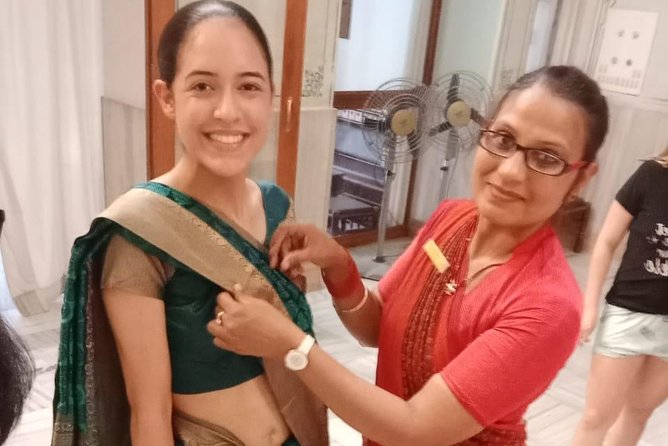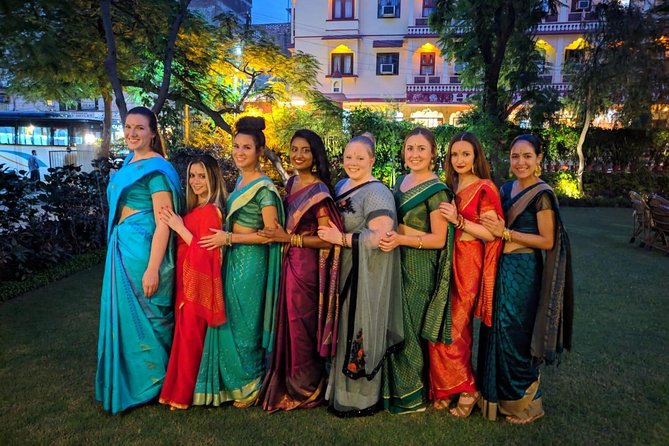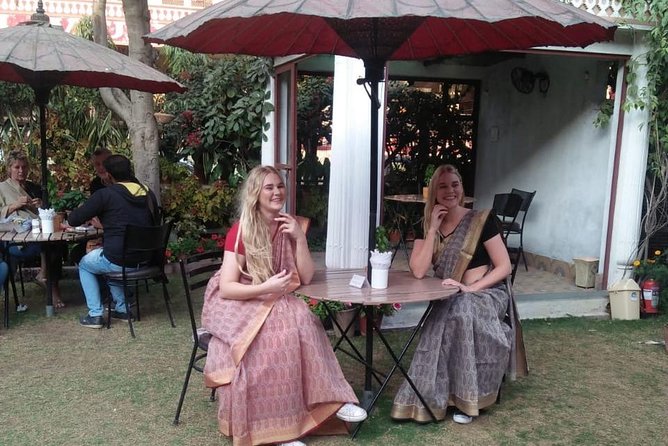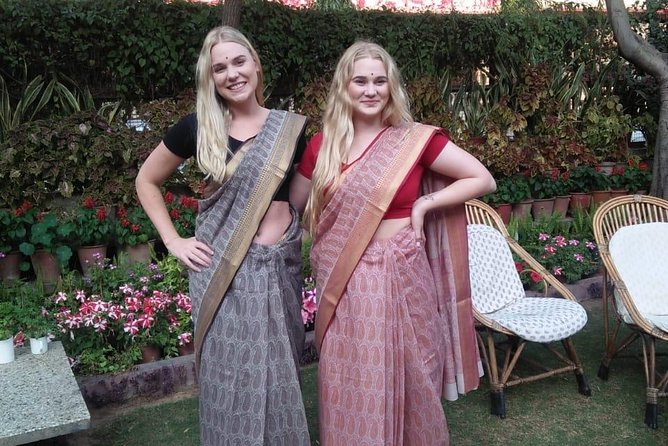The intricate art of saree draping unveils a tapestry of timeless elegance, woven with the threads of tradition and cultural heritage. Each fold and pleat of the saree tells a story of grace and sophistication, passed down through generations with a sense of reverence. From the vibrant hues of traditional Indian sarees to the delicate craftsmanship that adorns them, the allure of saree draping transcends mere fashion; it embodies a profound connection to the rich tapestry of Indian culture.
Good To Know

- Saree draping reflects centuries-old tradition and elegance.
- Various regional draping styles showcase cultural diversity.
- Traditional sarees like Banarasi and Kanjeevaram embody timeless beauty.
- Accessories like statement jewelry elevate the saree look.
- Saree draping transcends generations, symbolizing grace and sophistication.
History of Indian Saree Draping

The rich and intricate history of Indian Saree draping dates back centuries, showcasing a tapestry of culture, tradition, and artistry woven into every fold and pleat.
Originating in the the Indus Valley Civilization around 2800-1800 BC, the saree has evolved through various dynasties, invasions, and cultural exchanges, reflecting the diverse influences on Indian society.
Over time, different regions in India developed their unique draping styles, materials, and embroidery techniques, adding to the saree’s charm and versatility.
From the graceful Nivi drape of Andhra Pradesh to the royal Dravidian style of Tamil Nadu, each method tells a story of heritage and identity.
The saree has transcended generations, embodying grace, elegance, and timeless beauty in every wrap.
Find more activities and experiences we've covered in Jaipur.
Significance of Saree in Indian Culture
In Indian culture, the saree stands as a symbol of tradition, beauty, and grace, embodying a rich heritage that transcends time. The significance of the saree goes beyond just being a piece of clothing; it holds cultural and social importance ingrained in the fabric of Indian society.
Here are four key aspects that highlight the importance of the saree:
Cultural Identity: The saree is a symbol of cultural identity, representing the diversity and unity of Indian traditions.
Celebratory Attire: Wearing a saree is often reserved for special occasions like weddings, festivals, and ceremonies, signifying joy and celebration.
Feminine Empowerment: The saree symbolizes feminine grace, strength, and elegance, empowering women in their self-expression.
Passing Down Traditions: Through generations, the saree has been passed down, carrying with it stories and customs that connect past, present, and future.
Techniques for Perfect Saree Draping

Mastering the art of saree draping requires precision and practice to achieve a flawless look that exudes elegance and charm. To start, ensure the petticoat is tied securely at the waist.
Begin tucking the saree into the petticoat, starting from the right, and make neat pleats. Drape the fabric once around the waist, ensuring the length is appropriate.
Next, bring the pallu (the loose end) over the left shoulder, pleat it neatly, and secure it with a pin. Adjust the pallu’s length and the pleats for a polished finish.
Types of Traditional Indian Sarees
Discover an array of exquisite traditional Indian sarees, each unique in its design and cultural significance. Traditional Indian sarees come in various styles and fabrics, reflecting the rich heritage of India.
Here are four popular types:
Banarasi Sarees: Known for their intricate gold and silver zari work, these sarees originate from Varanasi and are a symbol of opulence.
Kanjeevaram Sarees: Hailing from Tamil Nadu, these sarees are characterized by their heavy silk material and vibrant colors, perfect for weddings and special occasions.
Bandhani Sarees: Originating from Rajasthan and Gujarat, these sarees feature tie-dye patterns created by skilled artisans, adding a playful touch to any outfit.
Chanderi Sarees: Coming from Madhya Pradesh, these sarees are lightweight with sheer texture and are adorned with traditional motifs, ideal for a graceful look.
Accessories to Enhance Saree Look

Enhance the elegance of your saree ensemble with carefully selected accessories that complement your look.
A statement necklace or chandelier earrings can add a touch of glamour to your outfit, while a stack of bangles or a delicate bracelet can bring a subtle sophistication.
Consider a stylish clutch or potli bag to complete your attire elegantly. Opt for traditional juttis or embellished heels to elevate your overall appearance.
A decorative bindi or a pair of ornate hairpins can enhance the traditional aesthetic of the saree.
Saree Draping Etiquette and Tips
To drape a saree elegantly, ensure that the fabric is smooth and free of wrinkles before starting the draping process.
Here are some etiquette and tips to help you achieve a flawless saree look:
Choose the Right Fabric: Opt for fabrics like chiffon or georgette for a flowing drape.
Secure the Pleats: Pin the pleats neatly to keep them in place throughout the day.
Adjust the Pallu Length: The length of the pallu can affect the overall look, so adjust it to your comfort.
Accessorize Thoughtfully: Pair your saree with the right accessories like statement jewelry and matching footwear to complete the ensemble.
Evolution of Saree Draping Styles
The evolution of saree draping styles showcases a rich tapestry of cultural influences and fashion trends over the centuries. From the ancient times of the Indus Valley Civilization to the modern-day runways, the saree has adapted and transformed, reflecting the changing tastes and aesthetics of each era. Below is a glimpse into the evolution of saree draping styles:
| Period | Draping Style | Key Features |
|---|---|---|
| Indus Valley | Nivi | Pleated pallu over the shoulder |
| Mughal Era | Seedha Pallu | Rich fabrics, elaborate borders |
| British Colonial | Bengali Style | Thin, lightweight fabrics |
| Post-Independence | Gujarati Style | Front pallu, intricate pleats |
| Modern Times | Contemporary Fusion | Mix of traditional and modern elements |
Modern Twist to Traditional Saree Wear
Adding a modern twist to traditional saree wear infuses a fresh vibrancy into the timeless elegance of this cultural attire. Embracing contemporary elements while donning a saree can make a bold fashion statement and appeal to a younger audience.
Some popular ways to incorporate a modern touch to traditional saree wear include:
Pairing a saree with a trendy crop top or off-shoulder blouse.
Experimenting with unconventional draping styles such as the dhoti saree or pant saree.
Accessorizing with statement jewelry or a stylish belt to accentuate the look.
Opting for unconventional fabrics like denim or silk blends for a unique twist.
Frequently Asked Questions
Is Prior Experience Required to Participate in the Saree Draping Class?
No, prior experience is not required to participate in the saree draping class. Guests of all skill levels can join to learn the timeless art of traditional Indian saree draping. Enjoy a hands-on experience in a welcoming environment.
Can Participants Choose the Color or Design of the Saree Provided?
Participants can choose the color or design of the saree provided. They have the freedom to select their preferred style, ensuring a personalized experience. This option adds a touch of individuality to the timeless tradition of saree draping.
Are There Any Age Restrictions for Joining the Saree Draping Activity?
There are no age restrictions for joining the saree draping activity. Participants of all ages can enjoy learning the timeless art of traditional Indian saree draping at this inclusive and accessible experience in Jaipur, India.
Is There a Specific Way to Care for the Saree Received as a Gift?
To care for the saree received as a gift, it’s recommended to hand wash in cold water with mild detergent and avoid wringing. Drying in shade helps retain colors. Iron on low heat with a fabric between iron and saree.
Are There Any Group Discounts Available for Booking the Saree Draping Experience?
Group discounts are not available for booking the saree draping experience. However, the activity offers a brand new sari with blouse and petticoat as a gift. Secure your spot now and pay later for this elegant traditional Indian experience.
The Sum Up
To sum it up, the art of saree draping is a timeless tradition that showcases the beauty and grace of Indian culture.
From its rich history to the intricate techniques involved, the saree holds a special place in the hearts of many.
By incorporating modern twists and accessories, the traditional saree continues to evolve while staying true to its roots.
Embrace the elegance and sophistication of the saree, a symbol of feminine strength and cultural heritage.
More Tour Reviews in Jaipur
- Explore Local Experience Jaipur Sightseeing Tour by Car + Guide
- Taj Mahal City Tour by Car or Train From Jaipur
- 10-Days Jaipur, Udaipur, Mount Abu, Jodhpur & Jaisalmer Tour
- Tour of Abhaneri and Fatehpur Sikri From Jaipur With Agra Dropoff
- Drop Agra City With Visit Chand Baori and Fatehpur Sikri From Jaipur.
- Private Jaipur Half-Day Tour: Amer Fort, Jal Mahal, and Stepwell
Looking for something different? Other Jaipur activities we've written about
- Explore Local Experience Jaipur Sightseeing Tour by Car + Guide
- Taj Mahal City Tour by Car or Train From Jaipur
- 25 Best Shopping Tours In Jaipur
- 25 Best Workshops And Classes In Jaipur
- 20 Best Historical Tours In Jaipur
- 25 Best Tours In Jaipur
- 20 Best 3 Day Tours In Jaipur
- 11 Best Airport Transfers In Jaipur
- 16 Best 4 Day Tours In Jaipur
- 20 Best Private Driver Services In Jaipur
- 20 Best Full-Day Tours In Jaipur
- 25 Best Safari Tours In Jaipur
